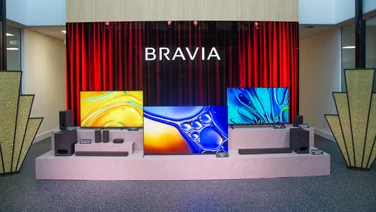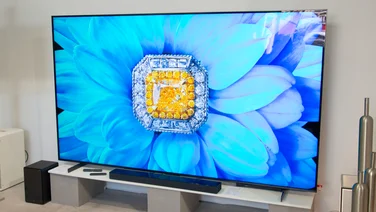To help us provide you with free impartial advice, we may earn a commission if you buy through links on our site. Learn more

It might sound like an exaggeration, but LCD screens are everywhere these days. The fact is, in their various guises LCDs are in everything from watches to phones, through to video projectors and, of course, televisions. When it comes to TVs, LCDs are often erroneously referred to as LED TVs, but in fact the LED TVs we hear about are just using LEDs to provide the light which shines through the LCD panel.
As things stand at the moment, LCD is the dominant technology in televisions. Plasma TVs and OLED TVs are both far smaller markets, with plasma on its way out, and OLED just starting to be introduced in volume and at prices affordable (well almost) to normal people.
History of LCD TVs
Although we’re looking at TVs and TV technology here, it’s worth understanding what a revolution LCD was in general terms. The discovery of liquid crystal dates back to 1888, which is somewhat staggering. Like many discoveries, back then scientist Friedrich Reinitzer got a lot of attention for what he found when extracting cholesterol from carrots. The problem was, no one could think of anything to do with this newfound technology.
Several years later, after work continued on these liquid crystals, in 1936 the Marconi Wireless Telegraph Company would patent the “liquid crystal light valve”, which was the first time a display had been created by selectively blocking light.

LCDs would, eventually be a major part of technology. Watches, calculators, laptops, mobile phones and cars would include one or more of them. Obviously, there is a difference between the screen of a calculator and that of a TV. For one, a calculator usually doesn’t have a backlight. Instead, lights passes from the front, where the user is, and is then reflected back through a reflective surface. In a TV, there’s a backlight that provides this light source.
And, of course, calculator LCDs are made of large areas of liquid crystal, and are generally not colour. TVs and other displays use pixels of different colours to produce an image. It’s the same method of producing an image that has existed since the first cathode ray tube colour televisions.
The most significant development happened in 1972, when Westinghouse produced the first active matrix screen. In an active matrix display, each pixel is controlled individually, which is crucial in using an LCD to create a complex, high-resolution image as seen on a computer monitor, phone or television.
In 1988 Sharp sold a 14in LCD TV as a special interest product, much like Sony’s XEL-1 OLED TV, it was never really intended to be a mass-market product, and was more something wealthy people might buy to make their homes look interesting. By 2004 the technology was much more viable, and small LCD TVs were on sale, although again their pricing meant that most people would still buy a CRT.

By 2007 things were on the move though, and for the first time LCD TV sales exceeded those of CRT televisions. People wanted those flat-panel TVs and a revolution started that killed the CRT within just a few years, ushered in HD, 3D and later 4K.
How does LCD TV work?
LCD TVs all work in the same way. At the back of the set is a backlight, which is on all of the time, producing the light that you see. In front of the backlight are two polarising filters. The first blocks all vertical light waves, the second, rotated 90 degrees, blocks all horizontal light waves. Together, then, they block all the light from the backlight, creating a completley blank screen.
That’s no use, obviously, but this is where the layer of liquid crystals come in. in their natural state, a liquid crystal is twisted, changing the orientation of the light. This means that light is allowed to pass through the second filter, creating a completely white screen. To control the light through the filter, a voltage is applied to each liquid crystal. Controlling the voltage controls the twist, and therefore controls how much light makes it through the second filter. Using this system and one liquid crystal per pixel, you can create a black and white picture with shades of grey.
In order to produce a full-colour image, each pixel is actually made up of three sub-pixels. These sit, respectively, behind a colour filter of red, green and blue: controlling the light that passes through each of these sub-pixels allows the TV to produce a picture with thousands of colours. The big downside with this technology is that the filters aren’t capable of completely blocking all light, so with a permanent backlight there’s always a bit of light bleed and, depending on the quality of the set, blacks can look more like dark grey.

There are two kinds of LCD panel in use today, the first is called “twisted nematic” or TN, and it requires voltage from an electrode above and below the LCD panel. The second technology is called “in plane switching” and instead uses two electrodes on one side of the panel.
IPS panels are very common now, because they have far better viewing angles and more faithful colour reproduction. TN panels are used a lot, but generally in cheaper displays. They are still common in computer monitors, especially those aimed at gamers who value low response times over image quality.
Types of backlight
The first LCD TVs were lit by something known as a CCFL or cold cathode fluorescent lamps. These are essentially the same sort of tubes that you would find lighting an office, although they are smaller when used in a TV. The technology works by producing ultraviolet light, which then excites a white coating on the inside of the tube, causing it to glow.
In a CCFL TV you would get a number of these tubes, arranged to distribute light as evenly as possible. A light diffuser fitted between the CCFL tubes and the LCD panel itself would help to ensure that the light had as few “hot” spots as possible. In the early days of LCD displays, good TVs would be those that had the most even light output.

The biggest problem with a CCFL backlight is that it lacks any real fine control. As LCD technology improved it was possible to dim sections of the backlight to help maintain black levels. For example, if the TV detected that the scene was very dark, it would dim the backlight to make the blacks inkier and bring out fine detail. However, with CCFL sets there was always a lot of light bleed which would give the LCD a grey/blue look when it was showing a black screen. This was always the biggest weakness of LCD TVs, and compared to plasmas at the time they were considered a much less capable display technology, although LCDs have some other advantages over plasma TVs.
Next along was the LED backlight, which itself comes in two variants. The first of which is technically edge-lighting, rather than backlighting. It was this system that revolutionised LCD TVs, because it allowed manufacturers to create models that were incredibly thin. It was this move that gave LCDs something of a boost over plasma TVs, which were often thick, heavy and sometimes even ugly. An LED illuminated TV can be hung on a wall, and that captured the imagination of both reviewers and the public.

In an LED edge-lit LCD TV the sides of the TV have an array of white LED lights, this light is then passed through a series of diffusers that distribute the light evenly across the LCD panel. In these TVs, especially early on, it would be quite common to have bright spots at the edges, often concentrated in the corners. This was undesirable, but on more expensive models the backlight was often very even, and looked great. Some degree of dimming control was possible, so blacks would appear better than CCFL TVs, but it was still not perfect.
Later on things advanced again, and we got LED backlights. This was a more expensive solution, but using this method you could have a direct source of light behind the LCD. This, as a rule, gave the most even picture and allowed for very bright TVs. However, there was an update to this technology that also allowed these LED backlights to be dimmed in zones. Depending on the number of LEDs and zones used, you could get an impressive level of control over the image contrast. For example, in a shot of a dark room with a bright window, the TV could dim all of the zones in the dark parts of the room, to bring out the detail, but increase the brightness in the window to bring out the detail in the light part of the image. This technology allowed black levels to approach those of plasma for the first time. Although early sets using this technology would sometimes show a white halo around objects, this was noticeable on end-credits of movies.
LCD vs Plasma vs OLED
There are several great things about LCDs. The first is that they offer a lot of brightness, really good colour and an incredibly sharp picture. While plasma TVs had a lot going for them too, LCDs were thinner, lighter and used less power. Then there was the burn-in issue, where a plasma could retain an image left on screen for too long – another problem LCD just didn’t have.
Of course, plasmas had a lot going for them too. Much better black levels being crucial, and with it a better contrast ratio and more realistic image. Plasmas also have a much faster refresh rate, which meant when 3D came along you’d get less crosstalk. But more importantly, if you’re a sports fan, then plasma would give you a much sharper image on moving objects. Viewing angles are also much better on most plasma TVs, and can be really poor on cheaper LCD TVs.
In theory though, OLED trumps them both. It takes all the good things about plasma, like amazing black levels and contrast, super-fast refresh rates and great viewing angles, and merges them with the strengths of LCD like the ability to do 4K – which is a problem for plasma – and amazing colour and brightness.
It’s fair to say plasma TVs have had their day as we enter a world of 4K. And while OLED has a lot of promise, it’s still the LCD TV that’s fighting on. These TVs look better than ever, and it’s likely that they will remain the number one selling display technology for a really long time.






